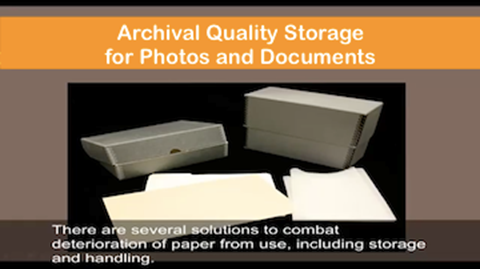- The Truth About Paper
- What is Paper Preservation?
- How is Paper Made?
- Hidden History of Papermaking
- Types of Paper and How They Degrade
- Rag Paper
- Acid Free Paper
- Wood Pulp Papers
- Coated Paper
- Proprietary Paper (photographs and other media paper)
- Transparent Paper
- Environmental Enemies of Photographs and Other Paper Documents
- Things that are Harmful to Photographs
- 6 Tips for Handling Photos and Important Documents
- Identifying Paper: Machine-Made vs. Handmade Paper
- Diagnostic Tests to Measure Acidity
- How to Preserve Photographs and Documents During Storage
- Dos and Donts of Packaging Documents and Photos for Storage
- Scrapbook and Album Storage
- How to Try to Preserve Papers and Photographs that are on Display
- The Reality of Protecting Valuable Documents From Fire
Learn how to prevent destruction and preserve personal and historical items for future generations. This page is designed to be the most extensive, and comprehensive page on the protection and preservation of paper on the internet. This page references every significant information source on paper preservation we are aware of. Please alert us immediately to any paper preservation information found in this page that is out of date.
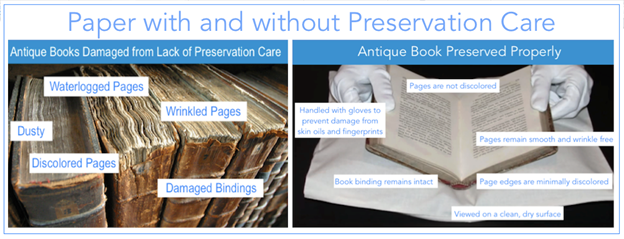
The above images depict old damaged books and a nicely preserved book. A special thanks to Tom Murphy VII - Own work, CC BY-SA 3.0, and David Ashman for the use of their images.
The Truth About Paper
Paper Defined
All paper, whether it is scrapbook paper, photos, tickets, or legal documents, is a material that is created in thin sheets primarily from plant based material called cellulose. Paper can hold inks or other mediums. Paper can be used for writing, printing, wrapping, drawing, decorating, and many other things. The types of paper are limitless.
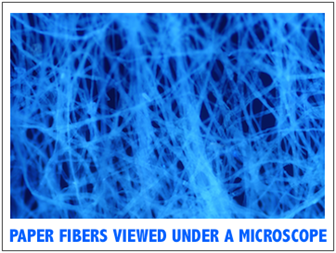 The above image shows what paper fibers look like under a microscope. Image provided by Richard Wheeler (Zephyris) - Own work, CC BY-SA 3.0.
The above image shows what paper fibers look like under a microscope. Image provided by Richard Wheeler (Zephyris) - Own work, CC BY-SA 3.0.
Cellulose
Cellulose is composed of plant fibers. Cellulose is found in the cell wall of most types of algae, oomycetes, and plants that are green in color. Cellulose is a polysaccharide that has a linear chain of glucose units. This chain consists of hundreds to thousands of glucose units. Cellulose is an organic polymer found in great abundance. Cotton fibers have a cellulose content of about 90%. Wood has a cellulose content of about 40 to 50 percent. Cellulose is most frequently obtained from cotton and wood pulp. Cellulose has the formula (C6H10O5)n.
"Papermaking Pt. 2 | How to Make Everything: Book” A video on how to hand make cotton and hemp paper. Thank you to “How To Make Everything” for the use of their video.
Paper Etymology
The word “paper” is derived from the term papyros, an Ancient Greek word. In Ancient Greece, papyros referred to the Cyperus papyrus plant. Papyrus Plant.
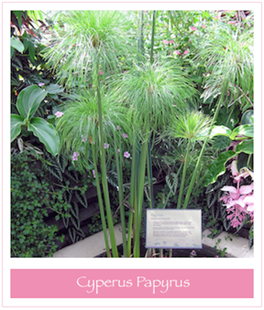
The above photo shows a papyrus plant. Image provided by Arpingstone - Public Domain
Papyrus was used for writing in Mediterranean cultures thousands of years prior to paper being created. Papyrus is a material that is paper-like however, paper is made from small fibers that changed in properties as they were broken down into tiny macerated pieces. Differently, papyrus is made of dried plants that have been woven together.
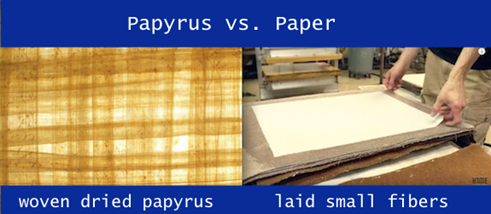
The above image depicts papyrus paper made from interwoven dried plants and laid cotton rag paper made by hand from broken-down cotton fibers. Images provided by B. SimpsonCairocamels - Own work, Public Domain and by How to Make Everything.
What is Paper Preservation?
Define Preservation
To preserve is to keep something alive, intact, or free from deterioration. Preservation is the act of preserving something; it is a process that protects organic items from decay.
Paper Preservation
Paper items can deteriorate over time. Different environments affect different types of paper to various degrees. To maintain the condition of paper documents, there are various methods of paper preservation.
How is paper made?
Paper is created from interconnecting fibers creating a mat or sheet. A screen is passed through broken down fibers that are floating in a liquid.
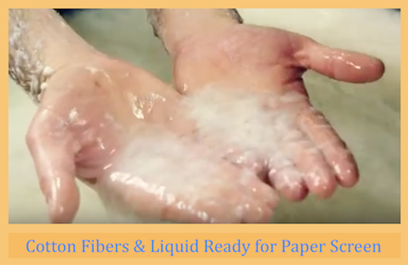
The above image depicts broken down cotton fibers floating in liquid. Image provided by “How To Make Everything.”
As the water drains through the screen, the screen is left with the felted sheet of interwoven fibers.
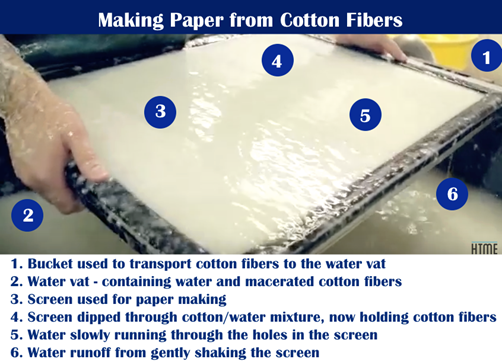
The above image shows cotton fibers and liquid on a papermaking screen. Thank you to “How To Make Everything” for the use of their image.
The sheet is taken off of the screen and given time to dry.
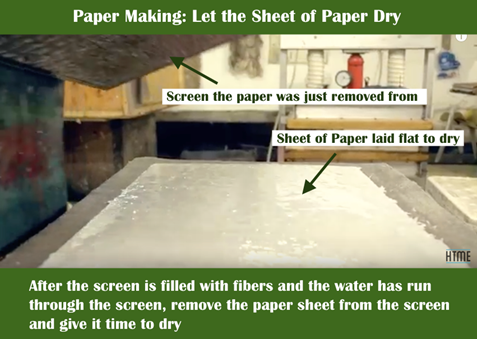 Thank you to “How To Make Everything” for the use of their image.
Thank you to “How To Make Everything” for the use of their image.
The paper sheet is removed from the screen to dry.
Cellulose is the main composition of the paper fibers. When cellulose mixes with water the cellulose materials adhere together which will create strong yet flexible paper. As opposed to handmade paper, paper can also be made with machines.
"HowStuffWorks Show: Episode 3: Paper Pulp" A video on making paper pulp from the HowStuffWorks Show on the Discovery Channel. Thank you to HowStuffWorks for the use of their video.
Hidden History of Papermaking
Early forms of paper, such as: papyrus (thick and made by laminating pith from a papyrus plant), parchment (made from animal skins), and vellum (parchment made from calf skins), wood bark, clay tablets, soapstone, shells, ivory, leaves, and bones, were in existence as early as 3200 B.C.
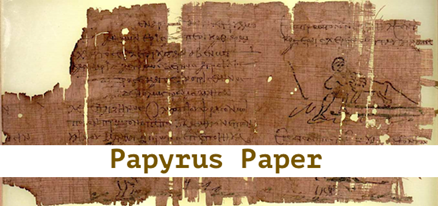
The above photo shows “Heracles Papyrus.” Dating somewhere from 201 to 300 A.D., this is a surviving piece of a manuscript. Image is Public Domain.
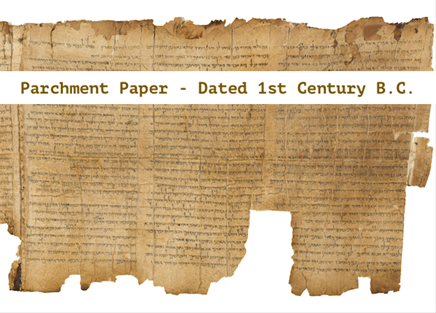
The above photo shows one of the excavated Dead Sea Scrolls. It is printed on parchment paper from 1-100 B.C. Image provided by Unknown - egE3f_wDueWd4A at Google Cultural Institute maximum zoom level, Public Domain.
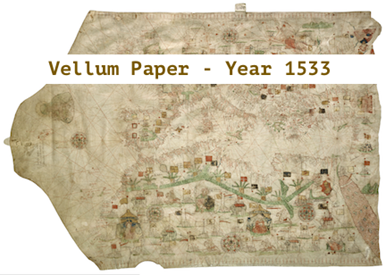
The above photo shows a map, from 1533, printed on vellum/calf skin. Image provided by Jacobo Russo of Messina - Nationaal Archief Nederland, Public Domain.
In china, the precursor to modern day paper can be dated as far back as the 2nd century B.C. (200-101 B.C.). This would include things like hemp paper.
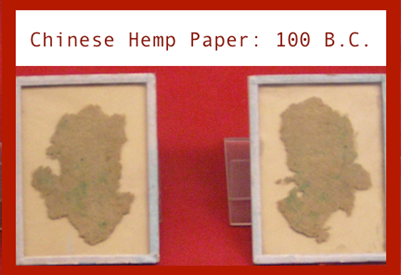
The above photo depicts Chinese hemp wrapping paper from 100 B.C. “Early Chinese hemp fiber paper...excavated from the Han Tomb of Wu Di (140-87 BC) at Baqiao, Xi'An.” Image provided by Ytrottier - Own work, CC BY-SA 3.0, Public Domain.
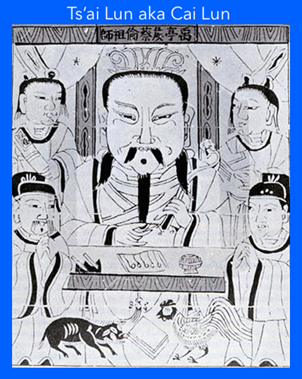
The above image shows Ts’ai Lun as the “patron of paper making.” It is from the Qing dynasty, eighteenth century. Image provided by Unknown - Gutenberg and the Koreans: The Invention of Paper, Public Domain.
In 105 A.D., or just prior, paper (as we recognize it today) was invented. This new papermaking formula and process was invented by a man named Ts’ai Lun. Ts’ai Lun, sometimes spelled Cai Lun, was a Chinese official for the Han Dynasty.
Prior to Ts’ai Lun’s papermaking process, heavy bamboos and expensive silks were used to write things on. Being heavy, bamboo made it difficult to transport correspondences. Silk was not cheap so using silk for inscriptions was costly. Ts’ai Lun thus created paper from tree bark, hemp fragments, fishing nets, and rags. In 105 A.D. Ts’ai Lun submitted the papermaking process to the emperor. It is said that, because of this great invention, the emperor gave Ts’ai Lun an aristocratic title. It has been said that Ts’ai Lun’s original papermaking formula has been lost.
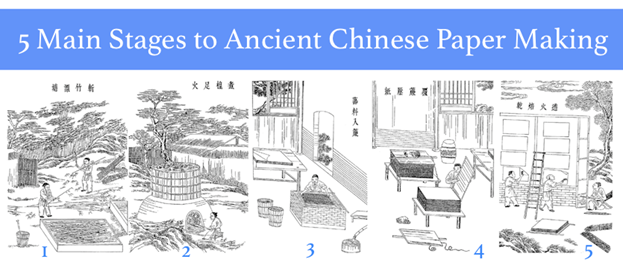
The above image depicts the 5 main stages to making Chinese paper. The images are of a woodcut of the Ming dynasty. Image originally uploaded by ? in Chinese Wikipedia. Public Domain.
Papermaking spread to the east and in 600 A.D. Korea began making paper. Then, in 610 A.D., a Korean monk took papermaking to Japan. This monk was named Don-cho. Papermaking made it to Tibet in approximately 650 A.D. and then spread to India in 645 A.D.
In 751 A.D. the Chinese T’ang army lost a battle to the Ottoman Turks. Chinese prisoners were taken captive. Some of these prisoners were people who made paper. This brought paper making to the Arab regions.
Sometime in the 10th century A.D. the Arabs taught papermaking to the Egyptians. In the 11th century papermaking continued into North Africa.
Due to the Crusades, in 1150 A.D. papermaking was finally established in Europe. 30 plus years later, in 1453 A.D., the Gutenberg press was invented by Johannes Gutenberg. In the late 15th century, England started creating big supplies of paper for the colonies.

The above image depicts Johannes Gutenberg, the inventor of the Gutenberg printing press. Thank you to Wikipedia for the use of this photo.
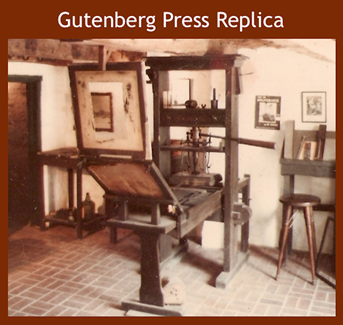
The above photo depicts a replica of the Gutenberg press. Image provided by Aodhdubh at English Wikipedia, CC BY 2.5
The first Unites States paper mill was constructed in Pennsylvania, in 1690.
Types of Paper and How They Degrade
There are many different types of paper, including: rag paper, transparent paper, coated paper, uncoated paper, photograph paper, acidic paper, acid-free paper, and wood-pulp paper. Paper deteriorates at different rates. The deterioration rates depend on things like what the paper is made of, what the paper was potentially coated with, what the paper has come in contact with, and where it is stored.
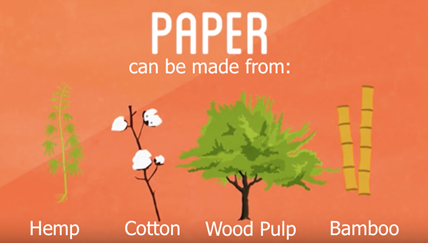
A special thanks to “How To Make Everything” for the use of their image.
The above image reveals that paper is made from press fibers from plants, such as: cotton, hemp, bamboo, and wood pulp.
I. Rag Papers
Rag paper can be made from hemp strands, linen, flax, or cotton. Rag paper was originally made from textiles that had been discarded.
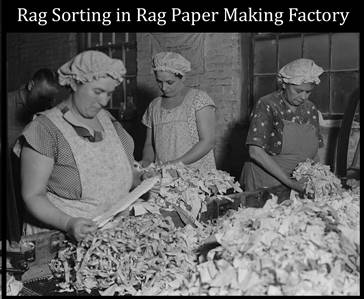
“Mt. Holyoke, Massachusetts - Paper. American Writing Paper Co. Rag sorting (French)” Thank you to Lewis Hine, the National Archives and Records Administration, and Wikipedia for the use of this public domain photo.
The above image shows women hand-sorting rags to make rag paper. Cotton is the normal material used for modern rag paper. Sometimes synthetic materials are also added to the cotton fibers.
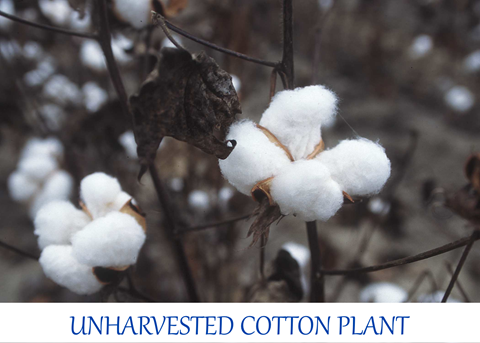 Image is Public Domain, https://commons.wikimedia.org/w/index.php?curid=689304
Image is Public Domain, https://commons.wikimedia.org/w/index.php?curid=689304
The above image is of a cotton plant prior to harvesting.
Higher-grade rag paper (used for fine art) is normally made up of cotton rag fibers that are lengthy and cellulose fibers that are short. These short fibers are known as cotton linters. During the processing of cotton, cotton linters are created.
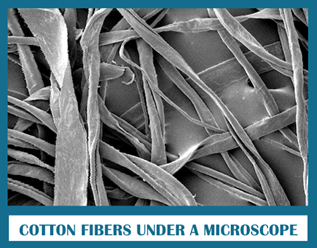
The above shows cotton fibers under a microscope. Image provided by Featheredtar - Own work, CC BY 3.0.
Laid rag paper is more frequently occurring but during manufacturing, rag paper can be wove or laid. Wove paper refers to paper with a uniform writing surface. There are no watermarks or ridges. Laid paper has a texture and is ribbed.
"From Rags to Paper" A video of James Burke talking about paper was made from rags. Thank you to Hughes Math for the use of their video.
Rag Paper Degradation
Rag paper is durable. Because rag paper is made up of sturdy, elongated, pure cellulose fibers the paper is chemically and physically stable.
Rag paper can be affected by peripheral elements that can make the rag paper become brittle or discolored. These outside enemies of rag paper include pollutants from the environment, heat, high humidity, and acid that can transfer from one object to the rag paper.
Rag Paper Deterioration Rate
Rag paper deteriorates very slowly. Old rag paper (from the 16th century) can still be found that is physically flexible yet sturdy and light in hue. Rag paper can survive for many centuries.
II. Acid-Free Papers
Any paper that is sulfur, lignin, and acidic pulp free can be considered acid-free paper if it has a pH greater than 7 (alkaline) or a pH of 7 (neutral).
The above image reveals that paper is made from press fibers from plants, such as: cotton, hemp, bamboo, and wood pulp.
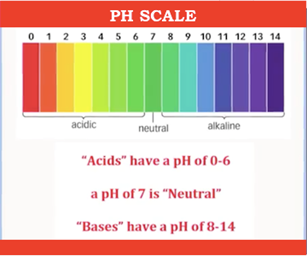
Thank you to Archival Methods for the use of their image.
The above image depicts the ranges of pH that make something acidic, neutral, or acid free.
Wood pulp and cotton rag can be used to create acid-free paper. However, wood pulp contains lignin. Lignin is acidic.
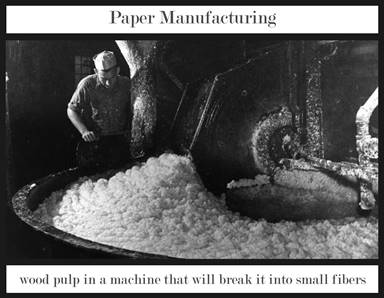 Cantonment, Florida, No restrictions.
Cantonment, Florida, No restrictions.The above image is of a paper mill worker running a machine containing bleached wood pulp. Image provided by Florida Memory - A worker mixing the pulp at the Florida Pulp and Paper Company mill
If wood pulp is utilized, many times it must also be alkaline-buffered to be considered acid-free. An acid-free grade is determined during the time of paper production. This acid-free grade does not guarantee long-term, acid-free permanence.
1. Acid-Free Permanent Paper
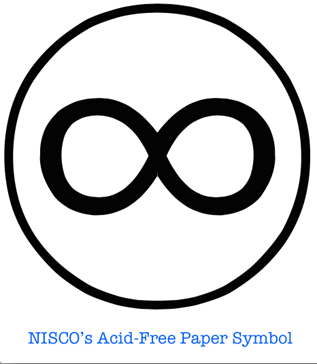
The above image is the NISCO acid-free paper symbol. Image provided by User:GAllegre - en:Image:Acid-free_paper.png, CC BY 2.5, https://commons.wikimedia.org/w/index.php?curid=1718665
In the United States, permanent paper is the standard paper that should be used for important paper documents that need to be preserved. Permanent paper is acid-free paper that meets specific standards.
For coated and uncoated paper that is made to survive for many centuries (under usual use), the United States has a specific standard, ANSI/NISO Z39.48. ANSI stands for the American National Standard for Information Sciences. It was first written in 1984 and then later revised in 1992. ANSI/NISO Z39.48 specifies the pH, alkaline reserve, lignin levels, paper stock, and tear resistance paper must have to be considered permanent paper.
In the 1990’s, a permanent paper international standard was issued, ISO 9706. ISO refers to the International Organization for Standardization. ISO 9706 complies with the technical standards of the 1992 version of ANSI/NISO Z39.48 however, the oxidation resistance and tear resistance restrictive standards are marginally different.
Permanent paper must be acid-free however not all acid-free paper will meet the ISO 9706 or ANSI/NISO Z39.48 standards to be labeled as permanent paper.
Specific paper that is acid-free and meets the ISO 9706 or ANSI/NISO Z39.48 standards can be packaged with a declaration of compliance and/or labeled with a circle with the infinity symbol inside of it. This symbol was created by the US National Information Standards Organization (NISCO). The NISCO infinity symbol is sometimes seen as a watermark on paper.
2. Acid-Free Archival Paper
- Archival-Grade Paper: This museum-grade paper is made of cotton rag pulp and is acid-free. Paper that is deemed “Archival” or museum-grade paper must meet a specific international standard, set by International Organization for Standardization (ISO), or must meet the United States ANSI/NISO Z39.48 standard. Rag pulp made archival-grade paper is many times more durable than acid-free permanent paper.
- Conservation-Grade Archival Paper: Paper that is given a conservation-grade paper status must be acid-free. Conservation-grade paper is mainly composed of wood pulp and is buffered.
Acid-Free Paper Degradation
Like all paper, acid-free paper is susceptible to staining and physical damage. Acid-free paper is acid-free and thus constructed to resist the deterioration materials that contain acid undergo, such as yellowing in color and becoming brittle. It should be noted that paper is given the acid-free grade during manufacturing. Just because a paper is acid-free at manufacturing does not mean the acid-free status is stable and will remain at this acid free pH level. Acid-free paper should be used
Acid-Free Deterioration Rate
Acid-free permanent paper is constructed to withstand multiple centuries when it is used under normal conditions. Acid-free paper degrades slowly.
III. Wood Pulp Papers
Wood pulp paper is a soft paper mainly made of wood pulp that has been ground. A natural component of wood pulp is lignin. Lignin is acidic. With chemicals, lignin can be removed during the process of milling.
Newspapers, Newsletters, Flyers, Pamphlets, and Some Paperback Books
Wood pulp paper is off-white in color and has been widely used since the 1860s. Wood pulp paper has historically been used for printing newspapers however, in present-day, most newspapers are printed on paper made from recycled fibers. Prior to the 1860s, newspapers (and other pamphlets or publications that were not meant to last) were printed on paper constructed from the fibers of hemp, cotton, or straw.
When wood-based paper started being mass manufactured (with a machine) it helped make books and frequent newspaper prints achievable and reasonably priced.
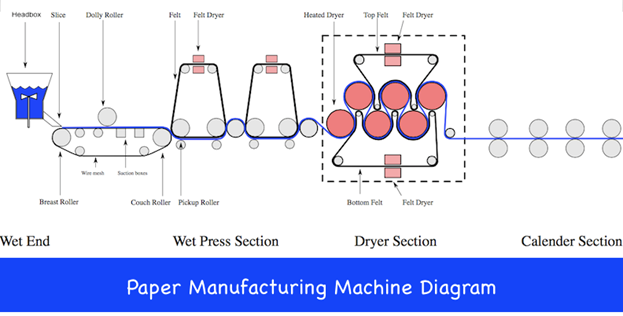
The above image is a diagram of the different sections of a machine that makes paper. Image provided by Egmason - Own work, CC BY 3.0, https://commons.wikimedia.org/w/index.php?curid=10482160
The mass manufacturing process however, did not include getting rid of the lignin from the wood pulp. Since lignin is acidic, this mean that paper made of this low-quality wood pulp would be susceptible to oxidation and quick deterioration. Oxidation causes paper to become weak and yellow.
Wood pulp paper can be of a higher or lower quality. Lower quality wood pulp paper is what newspaper or pamphlets are printed on. Higher quality, sturdier wood pulp paper is usually used when producing large runs of paperback books.
Wood pulp paper used for newspapers is sometimes tinted to look light blue, light pink, or light yellow.
Wood Pulp Paper Degradation
Wood pulp contains lignin. Lignin is acidic and can lead to paper turning yellow and brittle. If the acidic paper is exposed to heat or UV light then the paper will deteriorate more quickly. If the wood pulp paper degrades to a certain point it can be so brittle that the paper will fall apart when touched. If the paper has been folded, the crease line will usually fall apart more effortlessly.
Wood Pulp Paper Deterioration Rate
The high concentrations of acid in most wood pulp papers make the wood pulp paper quickly degrade.
Wood Pulp Paper Storage
An ideal storage situation may slow deterioration but it will not stop it. Ground wood pulp paper will unavoidable degrade due to its acidic concentration.
Wood Pulp Paper Reformatting Documents
To ensure the long-term preservation of the information in documents that were printed on wood pulp paper, reformatting is highly recommended. To save documents that are on wood pulp paper one can make a photocopy to preserve. The photocopy should be made on permanent paper. Other options are to microfilm the document or create a digital preservation copy.
"How to Preserve a Newspaper Clipping” A video on how to preserve and store newspaper clippings. Thank you to How Cast for use of their video.
IV. Coated Paper
Both plant fiber paper and wood fiber paper can be used as the base for coated paper. The coatings that are utilized will differ contingent upon the intended use of the paper.
Reasons for Paper Coating:
- To make paper made of recycled or lower-grade pulps better looking
- To make the paper surface glossy
- To form a uniform paper surface
- To make the paper smoother
- To make the paper more opaque
- Gives a better surface for printing
The ingredients utilized for coatings differ greatly. Some coatings add extra durability to the paper and can help the paper last longer. Other coatings can create instability and make the paper deteriorate faster. Common coating materials used for photography, color picture books, and magazines are calcium carbonate and clay. Earlier substances used for coatings were gelatin and wax. Today it is common for coatings to be made of a mix of synthetic and natural materials.
Coated Paper Degradation
Not all coatings are preservation friendly. Acidic materials can be found in some coatings. Acidic materials will cause paper to be come brittle and yellow over time. Water can irreversibly damage coated papers. If water gets on a stack of coated paper and the papers are not unstuck quickly, it is very likely that the papers will permanently bond together. Coated paper is also more susceptible to scratches and mars.
Coated Paper Deterioration Rate
Coated paper may deteriorate slowly to quickly, depending on the kind of coating used on the paper. Paper that was coated with the resin used early on in paper coating will normally degrade more quickly. Paper derived from lower-quality pulp diminishes the lifespan of any paper.
V. Proprietary Paper (photographs and other media paper)
Proprietary paper is considered paper that is connected with a specific method of formation. Examples of proprietary papers would be the paper used for inkjet print photographs or the paper used in thermal printing. Different proprietary papers are created for different uses and thus have unique specifications. Due to the varying uses, proprietary papers have many different mixtures of chemicals and other ingredients. For some papers, the ingredients used will unfavorably disturb the papers preservation qualities.
Here are a few types of paper that are considered proprietary (The different types of proprietary paper are vast. This is not a comprehensive list.):
1. Photograph Paper
Different Types of Photograph Paper:
- Developing Photograph Paper: This paper is also known as DOP. This type of photo is either enlarged from a negative or created via contact print. With use of a chemical developer, an image is created on DOP paper because the chemical developer process and exposure to light creates a latent image. These prints are blacks, neutrals, or blues. Unless the prints have been toned, these prints are normally cool in color.
- Printing-Out Photograph Paper: Also known as POP. This type of photo is also usually created via contact with a negative. This observable photo image is formed via light reactions onto light sensitive materials. Prints tend to be reddish, brown, or purple. These prints are warm in tone.
- Uncoated Photograph Paper: Uncoated paper does not have a layer of emulsion. Most times images will appear on this type of paper with the look of being within the paper, not on it.
- Coated Photograph Paper: The surface of coated paper does have a layer of emulsion. This emulsion layer will consist of collodion, gelatin, or albumen. Photographic salts that are light sensitive are held within the emulsion layer. Barium sulfate, or the bryta layer, is the third layer on the coated paper. The bryta layer exists between the image layer and the coated paper.
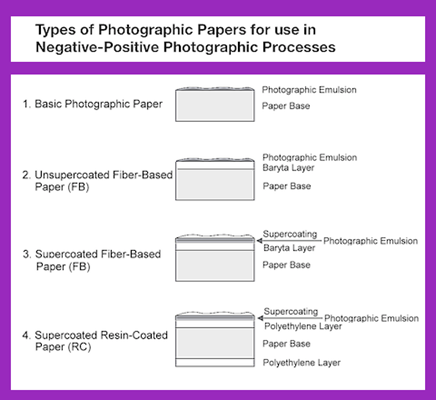 The above image depicts different kinds of photo paper. This is the kind of paper used for Negative/Positive Photographic Processes. Image provided by Rubberbandage SWeber - Own work, Public Domain, https://commons.wikimedia.org/w/index.php?curid=12617452
The above image depicts different kinds of photo paper. This is the kind of paper used for Negative/Positive Photographic Processes. Image provided by Rubberbandage SWeber - Own work, Public Domain, https://commons.wikimedia.org/w/index.php?curid=12617452- Printed Photograph Paper: Photographs that are digital and then printed from a camera (or computer) utilize ink. There are four general types of paper used for these types of prints: inkjet paper, bond paper, coated paper, and fine-art paper.
- Inkjet Paper: Made From: Inkjet paper varies in what it is made from. You can find inkjet paper that contains acid or is acid free. Degradation: The deterioration rate of this paper will vary depending on what ingredients are found in the paper.
- Bond Paper: Made From: Bond paper is made from wood pulp. Degradation: Wood pulp contains lignin, which is acidic. The lignin acidity will harm the paper and what it is printed on it over time. It will become brittle and discolored.
- Coated Inkjet Paper: This is inkjet paper with a coating that helps with the appearance and stability of the printed ink. Coatings can give this paper a glossy, matte, or luster finish.
- Made From: Coated inkjet paper varies in what it is made from. You can find coated inkjet paper that contains acid or is acid free. Degradation: The deterioration rate of coated inkjet paper will vary depending on what ingredients are found in the paper.
- Fine-Art and Scrapbook Paper: Made from: Fine art paper is made of 100% cotton-rag. There is no lignin in this paper. Degradation: Without lignin or rosin sizing, fine art paper is durable and stable.
2. Carbonless Copy Paper
Carbonless copy paper has been around since 1954. It is also known as NCR paper. NCR stands for National Cash Register paper and No Carbon Required paper. This paper can be used for many things including receipts and tickets. This coated paper usually comes in the form of a top sheet followed by a bottom sheet. When one writes on the top sheet it creates a duplicate of what is written on the bottom sheet. The top piece of paper is normally white. The bottom piece of paper is usually colored. The back of the top sheet is coated with a dye precursor, contained inside of microscopic capsules. When pressure is applied to the front of the top sheet it breaks the microcapsules. The dye precursor that was released then reacts with the acidic coating on the second sheet of paper. This creates an image where pressure was applied.
Degradation: Within a few years, total image loss can take place due to the acidity of the coating on the paper.
3. Inkjet Print Paper
Inkjet prints have been around since the 80’s. The composition of ink jet print paper varies. It can be acid free or acidic. It can be coated or uncoated.
Degradation: Varies depending on the paper composition and the coatings used.
Many times, proprietary papers have additives and chemicals that are acidic. Acidic materials can oxidize and turn the paper yellow or make it brittle. Acidic materials can also make images fade. If the paper was made from acid free materials it is likely that the paper will last longer.
Proprietary Paper Deterioration Rate
Since proprietary papers differ in composition, different proprietary papers will degrade at different rates. Most proprietary papers degrade more quickly. If the paper was not made from or treated with an acidic or volatile material then the paper should deteriorate more slowly.
Proprietary Paper Preservation
Anytime a document that is printed on proprietary paper starts to look yellow or becomes brittle it is vital that the document or photograph be photocopied onto permanent paper. This way, the information is preserved prior to the document becoming so damaged that the information is gone.
It is important to note that wood pulp paper can also impact other paper it is stored with. It is important to keep other types of important photos and paper documents away from these acidic wood pulp documents.
VI. Transparent Paper
Most transparent, or tracing, papers are made of thin and highly macerated fibers and are ivory in color. Sometimes the paper can be thick.
Somewhere near the 1850s, transparent paper started being widely used (by designers, architects, artists, and engineers) in order to trace copies of drawings and plans. Tracing paper was also used in the early twentieth century in the photochemical way of copying.
Transparent/Tracing Paper Uses:
- Tracing an image from a different piece of paper
- Certificates
- Ledgers
- Carbon Copies
- Legal Documents
- Drawing
The types of tracing paper are listed below:
1. Natural Tracing Paper
Natural tracing paper is made from highly beaten chemical wood fibers. The fibers are macerated to a condition where the sheet of paper has a surface that is evenly see-through. This paper is usually matte. It is highly transparent compared to other tracing papers. Natural tracing paper may have a coating over the surface of the paper. Some natural tracing paper is run through a calender machine.
A calender is a machine that consists of multiple pressure rollers that flatten and smooth out the paper.
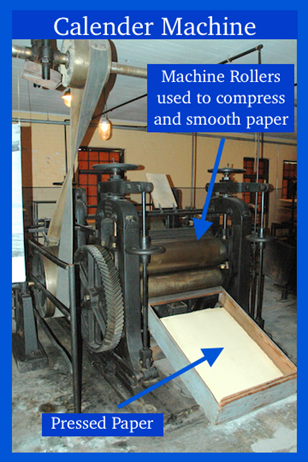
The above is an image of a paper calender machine used to smooth out paper. Image provided by I, Alexei Kouprianov, CC BY 2.5
2. Prepared Tracing Paper
There are different types of prepared tracing paper. Prior to the 1850s, tracing paper was made see-through via starch, varnish, or oil. In modern time, composites and/or resins are used to create the desired translucency.
a. Synthetic Vellum Paper
Synthetic vellum paper has been around since the 1850s. This smooth paper is still used today. It is constructed from wood pulp or fibers from cotton that have been treated with plastic. This paper has an even surface that, with light, is only partially see through. Synthetic vellum paper is mostly used for drawings and does not change in size with environmental changes.
b. Vegetable Parchment Paper
Vegetable parchment paper has been around since the 1850s. This is an acidic type of paper. This firm, thick paper is still used today. It is constructed from chemical wood pulp or rag-stock. Sometime this paper has a surface pattern from the fibers it was made from.
Vegetable parchment paper becomes partially see-through via a sequence of processing:
- Treatment with acid
- Treatment with an alkaline neutralization
- Run through a calender machine
c. Imitation Parchment Paper
Imitation parchment paper has been in play since the early 1900’s. It is still used today. Imitation parchment paper is made from chemical wood pulp that has been highly beaten then put through a calender machine to create a smooth surface. This imitation parchment is mostly used from food packaging, such as wrapping meat at the meat counter or cheese at the deli. Most of the time, parchment paper is glossy. This glossy surface can make the surface difficult for writing. Some certificates and legal documents have been printed on parchment paper that is rag-based. This is not a frequent occurrence.
3. Onionskin Paper
Onionskin paper is not actually made of onion, like the name suggests. Traditionally, onionskin paper is made from cotton rag stock. Onionskin paper can also be made from wood pulp. This paper is tough and lightweight. It is usually yellow or white. It feels crispy compared to some softer, more flexible papers. This paper has a transparent appearance. Onionskin paper can be glazed. This paper has been used for carbon copies, for typewriter paper, in bibles, for tracing, and for origami.
Transparent Paper Degradation
Transparent papers tend to be more delicate due to their composition of overbeaten fibers, short fibers, and/or acidic properties. Vegetable parchment paper, imitation parchment paper, and natural tracing paper fall into this category.
In contrast, quality paper made from rag-stock and onionskin paper can be very strong and may last.
Evident smells may come from old prepared tracing papers. These papers may also let off oils that can mar close by documents. (To eliminate transfer of these oils, use acid-free sheets that have not been buffered to protect each side of the document.
Transparent Paper Deterioration Rate
The deterioration rate of tracing papers can be slow to fast. The rate will depend on what the paper was constructed from.
Some tracing paper is made from wood pulp. Wood pulp contains lignin. Lignin is acidic. Transparent paper made from wood pulp will degrade at a medium to quick rate.
Some transparent paper is made from rag-stock. Transparent paper made from rag-stock will degrade at a slow rate. Onionskin paper is usually composed of rag-stock so has a lesser rate of deterioration.
"General Paper Preservation Tips” A video on how paper degrades and how to preserve it. Thank you to the State Archives of North Carolina for the use of their video.
Environmental Enemies of Photographs and Other Paper Documents
1. High Heat
Heat contact will make paper degrade at a faster rate. It is said that for every 10 degrees Fahrenheit the temperature increases, the chemical degradation of paper and photographic materials roughly double. Degradation can be noted when the paper becomes brittle or yellow. Paper with a pH below 7 is considered acidic. Acidic paper will usually become yellow and brittle when exposed to high heat. Colored prints may quickly fade when paper is in contact with high heat.
The ideal temperature range for paper storage is between 35 degrees Fahrenheit and 65 degrees Fahrenheit. This converts to a range between 2 degrees Celsius and 18 degrees Celsius.
2. High Humidity
Too high relative humidity (rH) or inconsistent temperatures can lead to paper becoming distorted. High humidity is considered 69% rH or higher. If humidity becomes too high it can create a moist environment that will promote the growth of mold. High humidity can also promote insect activity in the area. Mold and insects can both cause irreversible damage to paper.
The ideal rH range for paper storage is 35 percent to 50 percent rH with fluctuations no greater than plus or minus 5% rH.
3. UV Light
Contact with light will make paper deteriorate at a faster rate. Deterioration is visibly detectable through the paper becoming yellow or brittle. Acidic paper will normally become both brittle and yellow when exposed to UV light. Colored prints can quickly fade when paper is in contact with UV light. Light damage is irreversible.
4. Water
Water can permanently damage paper. Paper that has been exposed to water may become brittle, shriveled, and crisp. Water can make multiple pieces of coated paper stick together where they will never separate unscathed.
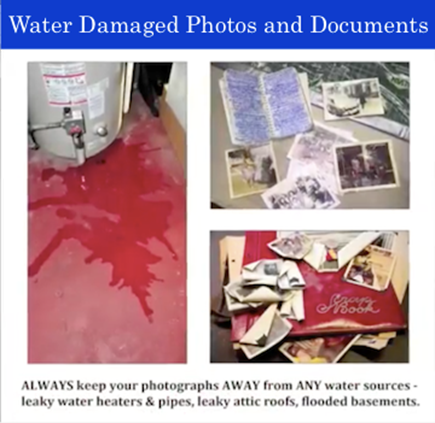
The above image depicts photos and a scrapbook damaged by water. Special thanks to Archival Methods for the use of their image.
5. Dust and Dirt
Paper surfaces can be forever discolored from dust, dirt, and soil being smashed into its fibers.
6. The Unknown Cause of Foxing
There is also a paper deterioration called Foxing. Foxing appears as reddish brown splotches on paper. The cause of foxing is unknown. One speculation is that foxing is caused by a fungus. Another speculation is that foxing is the oxidation of materials found in rag and pulp, such as copper and iron. High relative humidity might promote foxing.
7. Insects and Rodents
Insects and rodents can damage photographs and documents. If rodents are an issue, remove the documents from the infested area until the rodent issue has been rectified. If an insect infestation has occurred, move the photos or documents so that the insect infestation does not increase or transfer to nearby documents and photographs. Eradicate the insects, if possible. What should be done with the documents depends on the amount of damage done. A conservator may need to be consulted.
8. Mold
Mold can be harmful to paper and people, isolate the mold-infested area. Stop the molds source of nutrients – get rid of the moisture and water source. What should be done with the documents depends on the amount of damage done. A conservator may need to be consulted.
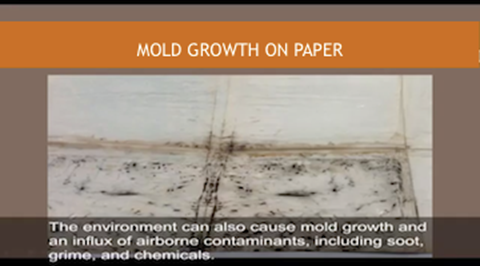
The above image reveals that mold growth can occur on paper documents. Thank you to the State Archives of North Carolina for the use of their image.
9. Acid
Papers with a pH below 7 are considered acidic. Paper with a pH of 7 is considered neutral/acid free. Paper with a pH above 7 is considered acid free. Paper that is acidic will naturally degrade quickly, turning yellow and brittle. Paper that is considered neutral and/or acid free can become acidic. This is a process that occurs because cellulose produces acid as time passes. Acid can also be transferred from one material to another. Acid is also in the environment and paper can absorb it. This is noticeable when the edges of the paper become brittle and change in color.
Things that are Harmful to Photographs
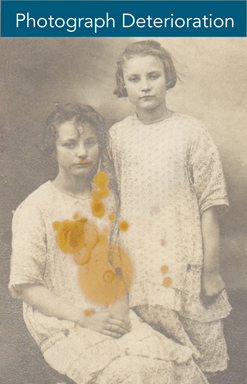
The above image depicts an old photograph that has deteriorated. Image provided by Michel Vuijlsteke - Own work, CC BY-SA 3.0
Photograph Deterioration
- Direct Sunlight
- Rodents
- Insects
- Adhesives that degrade
- Sulfur Compounds (these cause fading and can come from rubber and/or wood)
- Elevated Humidity that can lead to mold development
- Extreme Temperatures
- Fume emitting vinyl albums
"How to Preserve Your Family Photographs” A video on preserving family photos. A special thanks to Australian National Maritime Museum for the use of their video.
6 Tips for Handling Photos and Important Documents
- Wash your hands prior to handling photos or documents.
- Lotions can stain paper and potentially make it deteriorate. Do not apply lotion prior to handling important documents and photographs.
- Do not drink or eat food near photographs or important documents.
- Never smoke in the vicinity of the original photo or document.
- Prior to taking the photo or documents out of storage, prepare a clear and clean area to work with them.
- Your fingerprints have the ability to permanently stain photo negatives and printed photographs. Gloves should be worn when handling these items so that they are not damaged. You should hold photographs by their edges.
You can read more information on how to preserve your memorabilia here.
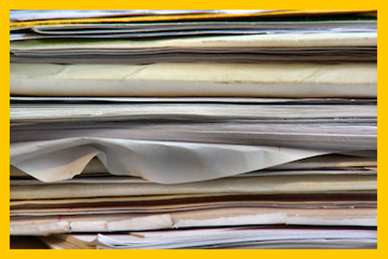
The above image shows a stack of different paper and folders. Image provided by Hobvias Sudoneighm
Identifying Paper
Machine-Made vs. Handmade Paper
Alignment of Fibers: Machine Made
One direction of fibers due to the machines rotary movement. Makes paper weaker in the direction of the grain. By tearing this paper in two directions, with the grain and against the grain, one can verify if the paper is one directional/machine made paper.
Alignment of Fibers: Handmade
Randomly intertwined fibers. Makes paper stronger.
Diagnostic Tests to Measure Acidity
PH Tests:
- Titration Testing: Cold and Hot Extraction. Must have a sample that can be destroyed. Uses controlled environment and pH meters.
- Surface pH Testing: pH pens, pH strips, or a chemical liquid.
"Mechanized Paper- Splitting” A video on the issues with acidic paper. Thank you to ZFBLeipzig for the use of their video.
Lignin Tests
- Lignin Chemical Testing: A destructible sample is needed for a chemical lignin test. Chemicals, bleach, and a sulfate process can remove lignin from wood pulp paper.
- Lignin Testing Pen: The pen will make lignin shine in a bright orange if lignin is present.
How to Preserve Photographs and Documents During Storage
To preserve the integrity of photos and other important documents there are certain conditions that should be minded when storing them.
"Care & Handling of Rare Books, Paper, Manuscripts, Photographs & Archives” A video on causes of damage and how to handle books, photographs, and documents. Thank you to David Ashman for the use of his video.
1. Low Relative Humidity
Relative humidity is a measurement of how much water vapor exists in the air. Water vapor is water in a gaseous state. Relative humidity, abbreviated as rH, is expressed as a percentage. Relative humidity is dependent upon temperature and pressure in a given area. In hot or warm air, more water vapor is needed to reach a high relative humidity. In cool or cold air, less water vapor is needed to reach a high relative humidity.
It is recommended that, wherever photographs and other paper documents are stored, the relative humidity is kept below 65 percent. An rH below 65% will help diminish insect activity and prevent mold growth.
2. Not Too Low Relative Humidity
Humidity below 65% is important to keep documents safe from mold and insects however, it is important to note that too low of relative humidity can create brittleness in your photographs and other paper documents. Relative humidity should not fall below 15%.
3. Low Temperature
Colder temperatures diminish insect activity and lessen the rate that chemical decay occurs at. It is recommended that the area where photographs and paper documents are stored be kept at a temperature below 75°F (23.89 degrees Celsius).
4. Decreasing Damage Risks of Photos and Other Documents
- Items should not be stored on the ground. Items should be stored on a shelf so that if there is a flood they will not get wet.
- Food and water are attractive to rats, mice, and insects. Food and water should be kept away from the area where important items are stored.
- Sunlight can degrade photos and documents. Try to store these items away from direct sunlight.
- Keep storage containers away from sources of leaks and floods. Sources of leaks and floods include windows, roof leaks, and pipes that may leak or burst.
5. Cold Storage for Specific Items
If stored at room temperature, certain items are susceptible to degradation and fading. This includes but is not limited to: slides, color negatives, prints, and acetate negatives. Storing these items in a cold storage may decrease the rate of deterioration.
Cold storage requires specific packaging, such as double bags that are vapor proof. Cold storage also requires that special steps be taken to ensure the safety of your items. These steps will vary depending on how your cold storage is set up.
Dos and Don’ts of Packaging Documents and Photos for Storage
The above image shows different archival packaging solutions. Special thanks to Archival Methods for the use of their image
1. Boxes
Different size boxes and types of boxes can be used to accommodate the storage on photographs and documents.
Boxes: The Dos
- Do use a document box that utilizes spacer boards to keep your photos or documents standing vertically, even when there are not enough documents to fill up the space. This will prevent the vertical documents from bending, folding, or flopping over.
- Do use a box where the storage folders fit perfectly inside. Use the correct size box for the documents you are storing.
- Do use boxes or containers that are large enough for your photos or documents to stand vertically or lay horizontally without bending, flopping, or folding over.
- Do use buffered or acid and lignin free storage containers, boxes, folders, envelopes, and other materials to store your photos and documents.
- Do use storage containers, boxes, folders, envelopes, and other materials that have passed the PAT test to store your photos.
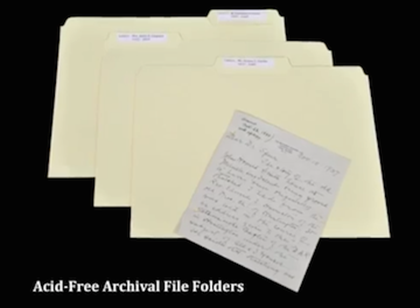
The above image shows acid free archival folders. Special thanks to Archival Methods for the use of their image
PAT: The Photographic Activity Test, or PAT, is a test used to evaluate display, decorative, and storage materials that may be used on photographs. This is an international standard test. It determines the effects of specific items (such as adhesives, paper, ink, framing, photo albums, glass, embellishments and other scrapbook supplies, labels, and other materials) on photos.
Boxes: The Don’ts
- Don’t use a folder where the paper sticks out the top, bottom, or side. This will lead to the edges of the photo or document getting damaged.
- Don’t use a box where the folders (and their contents) will fold, bend, or flop over inside of the box.
- Don’t put so many photos and documents into a storage container where the container is overstuffed. This can lead to damaged documents.
- Don’t use storage boxes, folders, envelopes or other storage items that contain lignin, or contain acid.
- Don’t use storage items for photographs that have not passed the Photographic Activity Test (PAT).
"Preserve Your Treasures: How To Store Your Photographs” A video from the Smithsonian Institute of Archives on how to store photographs. Thank you to SIArchives for the use of their video.
2. Rolls:
Flexible Sheets can be stored on rolls. This allows large documents or photographs to be stored without being folded or bent.
Rolls: The Dos
- Do use a strong and sturdy tube to roll your photograph or document onto. The stronger the tube the better; it will eliminate the likelihood of the roll being dented or compressed.
- Select a tube that is acid free
- Select a tube that is buffered and has a low-lignin content or a roll that is lignin free.
- Multiple sheets can be rolled onto 1 tube. Roll the sheets onto the tube at the same time.
- Roll the paper onto the tube slowly.
- Use a tube that is 2” longer (or more) than the photograph or paper document you are storing.
- After the documents are rolled onto the tube you should roll on an outside layer of bond paper or acid and lignin free paper. This layer will protect the back of the documents by shielding them from light.
- Add another protection layer. This layer should be a polyester film. This layer is there to protect the photos or documents from water.
- Use a ribbon or twill tape to secure the roll. Tie the ribbon or twill tape loosely.
Rolls: The Don’ts
- Don’t use a flimsy tube to roll your photograph or document onto. The weaker the tube is the more likelihood the roll will be dented or compressed.
- Don’t use a tube that contains acid.
- Don’t use a tube that contains lignin (unless it is buffered and has only a low-lignin content).
- Don’t roll multiple sheets onto the same roll one at a time.
- Don’t roll paper onto the roll quickly. This can create wrinkles.
- Don’t use a tube that is shorter than or just as long as the photograph or paper document you are storing.
- Don’t use acidic or lignin paper to protect the back of your photograph or document from light.
- Don’t forget to use an outer layer of polyester film to protect your document or photograph from water.
3. Protective Clear Sleeves:
Clear sleeves - also called page protectors or photo protectors can be used to protect photographs, documents and scrapbook pages from damage or further damage.
Protective Sleeves: The Dos
- Do use a clear polyester sleeve
- Do place photos or documents that are torn or brittle into sleeves to stop further damage.
- Do use clear sleeves for photos or documents that are used often.
- Do place only 1 item in each sleeve.
- Do use a sleeve that is larger than the photo or document. This will protect the whole photo or document from damage.
Sleeves: The Don’ts
- Don’t use a sleeve that is made of acidic materials.
- Don’t use a polyester sleeve to try to protect a page in a book. The edges of the polyester sleeve may lead to tears in the page of the book.
- Don’t place more that one item in each sleeve.
- Don’t use a sleeve that is smaller than the photo or document. If there are edges of the photo or document sticking out of the sleeve it is likely that it will be damaged.
4. Photo Albums:
Some albums damage photos and documents. Other albums are considered safe for photos and documents.
Albums: The Dos
- Do use an album with a cover made from stable plastic, leather, or cloth.
- Do fill the album to the specified capacity or below.
- Do use pages that are acid free to mount a photo or document within an album.
- Do use envelopes that are acid free to mount a photo or document within an album.
- Do use clear sleeves that are created with polypropylene, polyester, or polyethylene. These are stable plastics that will not damage the photo or document.
- Do use mounting corners constructed from stable plastics.
- Do use mounting corners constructed from acid free paper.
Albums: The Don’ts
- Don’t overfill an album. Overstuffing an album may cause damage to the pages or the items attached to the pages. Overstuffing an album may also make the album difficult to use.
- Don’t use pages or papers that are acidic to mount a photo or document within an album. Avoid "magnetic album" types.
- Don’t use envelopes that are acid to mount a photo or document within an album.
- Don’t use clear sleeves that are created from non-stable plastics.
- Don’t use mounting corners constructed from non-stable plastics.
- Don’t use mounting corners constructed from acidic paper.
5. Adhesives and Fasteners:
All adhesives and fasteners are not created equal. Specific adhesives and fasteners are approved for photograph and document storage while others should be avoided because they may be hard to remove, damage the photo or document, or over time they may discolor. You can learn more here.
Adhesives and Fasteners: The Dos
- Do use high quality adhesives and glues that have passed Photographic Activity Test (PAT).
- Do use high quality tapes that have passed Photographic Activity Test (PAT).
- Do use plastic covers that are made from stable plastics, such as polypropylene, polyester, or polyethylene.
- Do use paperclips or staples that are stainless steel. Stainless steel will ensure the paperclips and staples do not rust onto your documents.
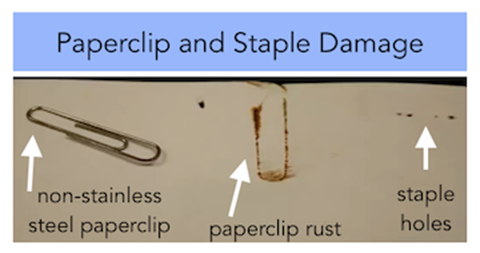
The above image shows a document where paperclips rusted onto the paper. Special thanks to Archival Methods for the use of their image
Adhesives and Fasteners: The Don’ts
- Don’t use poor quality or synthetic glue. Low quality/non-photograph safe adhesive can stain the front of a photograph or document even though it was applied to the back of the photograph or document. Examples would be hot glue and white glue.
- Don’t use rubber cement.
- Don’t use tape that is pressure sensitive.
- Don’t use rubber bands.
- Don’t use PVC plastics or plastics that you are unsure of.
- Don’t use albums that utilize a self-stick adhesive with a clear cover. These are also known as “Magnetic Albums.”
- Don’t use paper clips or staples that will rust.
Scrapbook and Album Storage
Scrapbooks and albums are excellent solutions for long-term photo and document storage. Scrapbooks and albums should be stored in boxes for long term care. These boxes should be kept up off the ground. Scrapbooks and albums should be kept flat within the storage boxes. Boxing is vital so that dirt does not make its way into the scrapbook to damage it. It is important to select the right album or scrapbook for your needs.
If there are items within the scrapbook that contain acid, or other volatile items like fasteners that are not rust proof, it is important to remove those items prior to storage. These items can damage the surrounding photos and documents. These items can be stored in clear sleeves and placed within the scrapbook in their original location or stored outside of the scrapbook.
How to Try to Preserve Papers and Photographs that are on Display
Occasional display of images and documents is recommended over constant display.
1. Glazing for Photos or Documents
Depending on your documents surface, use acrylic or glass. Acrylic can produce static electricity. This means that acrylic should not be used on certain media that is powdery. Both florescent and UV light harms documents and photos. Use a glaze that has UV filtering.
2. Framing and Matting for Photos or Documents
Use products (mat boards, spacers, glass, acrylic) that are not harmful to documents and photos. They should be 100% acid-free. Choose materials that are certified by the Photographic Activity Test (PAT). Spacers should be used to lift the glass and acrylic away from the surface of the document or photo.
3. Keeping Light Exposure to a Minimum for Photos or Documents
If possible, do not display the document or photo constantly. Rotate it in and out of display to avoid constant exposure. Avoid harmful lights. Daylight and florescent lights are more harmful that visible light due to their high UV rays. Choose glass or acrylic that has a UV filter. If they are not needed, turn off lights. If doable, close blinds over windows.
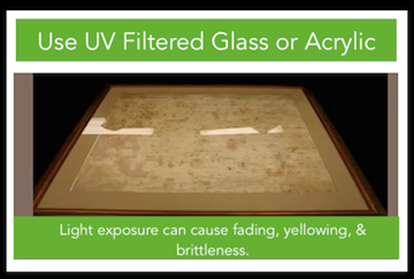
The above image shows a document protected from light by glass that is UV coated. Special thanks to Archival Methods for the use of their image
The Reality of Protecting Valuable Documents From Fire
Disasters happen. If there is an earthquake, the most important photos and documents can be unburied and salvaged. In a flood, depending on the severity and length, some photos and important documents may be dried out and saved. In a fire, the damages to unprotected photos and important documents are usually permanent.
There are a few options when trying to protect valuable or sentimental photographs and documents from fire:
- If possible, keep photocopies or reproductions of the original on display and keep the originals in a portable firebox. If a fire occurs, have this firebox located in a place where you can easily grab it and go at the first sign of danger.
- If possible, keep photocopies of the original on display at home and keep the originals in a safe place off site such as fireproof safety deposit box.
- Keep important document and photograph originals in a fireproof safe. There are different ratings for “fireproof” products. There should be a temperature max and a time limit on each product. This product labeling will tell you at what temperature limit your product will still maintain its integrity and for how long it can withstand this temperature.
- If possible make a scan or take a photo of old documents or photos and store a copy of the pictures backed up and stored digitally offsite.

